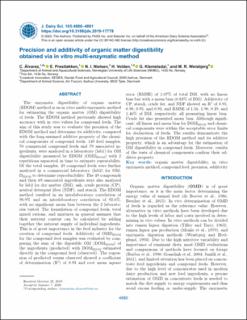| dc.description.abstract | The enzymatic digestibility of organic matter (EDOM) method is an in vitro multi-enzymatic method for estimating the organic matter (OM) digestibility of feeds. The EDOM method previously showed high accuracy with in vivo values for compound feeds. The aim of this study was to evaluate the precision of the EDOM method and determine its additivity, compared with the long-assumed additive property of the chemical components of compound feeds. 149 feed samples, 70 commercial compound feeds and 79 associated ingredients, were analyzed in a laboratory (lab1) for OM digestibility measured by EDOM (OMDEDOM) with 2 repetitions separated in time to estimate repeatability. Of the total samples, 49 compound feeds were further analyzed in a commercial laboratory (lab2) for OMDEDOM to determine reproducibility. The 49 compounds and their 69 associated ingredients were also analyzed by lab2 for dry matter (DM), ash, crude protein (CP), neutral detergent fiber (NDF), and starch. The EDOM method resulted in an intralaboratory correlation of 98.9% and an interlaboratory correlation of 92.6%, with no significant mean bias between the 2 laboratories tested. The formulation of compound feeds, total mixed rations, and mixtures in general assumes that their nutrient content can be calculated by adding together the nutrient supply of individual ingredients. This is of great importance in the feed industry for the creation of compound feeds. Additivity of OMDEDOM for the compound feed samples was evaluated by comparing the sum of the digestible OM (DOMEDOM) of the ingredients (predicted) with DOMEDOM estimated directly in the compound feed (observed). The regression of predicted versus observed showed a coefficient of determination (R2) of 0.93 and root mean square error (RMSE) of 1.07% of total DM, with no linear bias but with a mean bias (0.83% of DM). Additivity of CP, starch, crude fat, and NDF showed an R2 of 0.95, 0.98, 0.95, and 0.93, and RMSE of 1.56, 1.90, 0.39, and 1.46% of DM, respectively, all presenting linear bias. Crude fat also presented mean bias. Although significant, all linear and mean bias for DOMEDOM and chemical components were within the acceptable error limits for declaration of feeds. The results demonstrate the high precision of the EDOM method and its additive property, which is an advantage for the estimation of OM digestibility in compound feeds. Moreover, results of the tests of chemical components confirm their additive property. | en_US |

